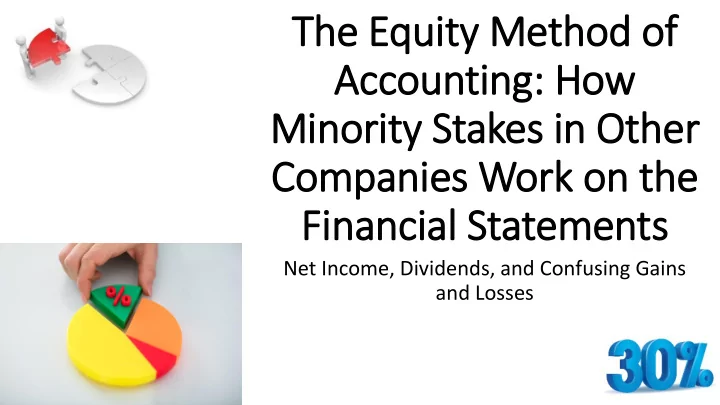

The Equity Method of Accounting: How Minority Stakes in Other Companies Work on the Financial Statements Net Income, Dividends, and Confusing Gains and Losses
Equity In Investments: Say What?! “Can you explain how the accounting for Equity Investments or Associate Companies works? Where do Net Income and Dividends go? What happens if a company changes its ownership percentage? What about Unrealized Gains and Losses?”
Equity Method Accounting: The Short Answer • Why: Used when one company has “significant influence,” but not control, over another company (e.g., 20-50% ownership stake) • Basic Idea: Parent Co. records Sub Co. Ownership Percentage * Sub Co.’s Net Income on its Income Statement under “Equity Investment Earnings” or a similar name • Then: Parent Co. will reverse that item on its CFS and record Sub Co. Ownership Percentage * Sub Co.’s Dividends as a positive on its CFS; both items link into Equity Investments on the BS • Changing Ownership Percentage: This gets tricky to explain, so let’s start with the basics in Excel first…
Part 1: Basic Minority-Stake Deal • Assumptions: Need the Sub Co.’s Market Cap and the percentage we want to acquire, as well as both companies’ statements • Cash Flow Statement: Record this acquisition as a cash outflow in Cash Flow from Investing, with Debt Issued below it in CFF • Balance Sheet: Link the Equity Investment line item to all the Equity Investment-related items on the CFS (Gains/Losses, Purchases/Sales, Net Income, and Dividends) • IS / CFS: Record Sub Co. Ownership Percentage in Period * Sub Co. Net Income on the IS, New Interest Expense, and Ownership Percentage * Sub Co. Dividends on the CFS
Part 2: Changing the Ownership Stake • Constraint: We’re going to limit the ownership percentage to 49%, at most, because above that, the accounting changes and gets much more complicated • Assumptions: Need the Sub Co.’s Market Cap and the new Ownership Percentage in each year (end-of-year changes only) • Easy Part: Percentage Change in Equity Investments and the Change in the Equity Investment Dollar Amount (Market Cap * % Change) • Harder: If the Parent Co.’s stake in the Sub Co. decreases , it sold some of its stake… which means we need to calculate the Realized Gain or Loss on it (Unrealized Gains/Losses do not show up)
Part 2: Changing the Ownership Stake • First: Calculate the Cost Basis right before the change, i.e., Old Equity Investments – Equity Investment Earnings – Equity Investment Dividends • Formula: =IF(Percentage Change is Negative, (Sub Co. Market Cap * Previous Ownership Percentage – Cost Basis) * – Percentage Change / Previous Ownership Percentage, 0) • Logic: We cannot possibly have a Gain or Loss if the Ownership Percentage has increased , so check that part first; if the percentage change is >= 0, set the Gain/Loss to 0
Part 2: Changing the Ownership Stake • Logic, Continued: Next part is easiest to understand with a specific example… let’s say the Sub Co. Market Cap is $150, Previous Ownership % is 30%, Cost Basis is $30, and New Ownership % is 15% • So: $150 * 30% = $45, and, therefore, the Total Gain or Loss is $45 – $30 = $15 • BUT we don’t necessarily sell the entire investment! • Last Part: Adjusts for this, so if we’re selling just 15%, 15% / 30% = 50%, so the Gain is $15 * 50% = $7.5 instead
Part 2: Changing the Ownership Stake • Linking the Statements: Realized Gains and Losses always appear on the IS and are reversed on the CFS • Cash Flow from Investing: The Purchase / Sale of Equity Investments line item handles the rest – that, plus the Gain or Loss, equals the change in the Equity Investment line item • Testing: Try different Ownership Percentages, Market Caps, Debt/Cash splits, etc., to test this model
Recap and Summary • Equity Method: Used when one company has “significant influence,” but not control, over another company (e.g., 20 -50% ownership stake) • Basic Idea: Parent Co. records Sub Co. Ownership Percentage * Sub Co.’s Net Income on its Income Statement under “Equity Investment Earnings” or a similar name • Then: Parent Co. reverses that item on its CFS and records Sub Co. Ownership Percentage * Sub Co.’s Dividends as a positive; both items link into Equity Investments on the BS • Changing Ownership Percentage: Calculate the Cost Basis…
Recap and Summary • Gain or Loss Formula: =IF(Percentage Change is Negative, (Sub Co. Market Cap * Previous Ownership Percentage – Cost Basis) * – Percentage Change / Previous Ownership Percentage, 0) • Why: Adjusts for the fact that the company might sell only part of its stake, not the entire investment, and reduces the Gain or Loss proportionally
Recommend
More recommend